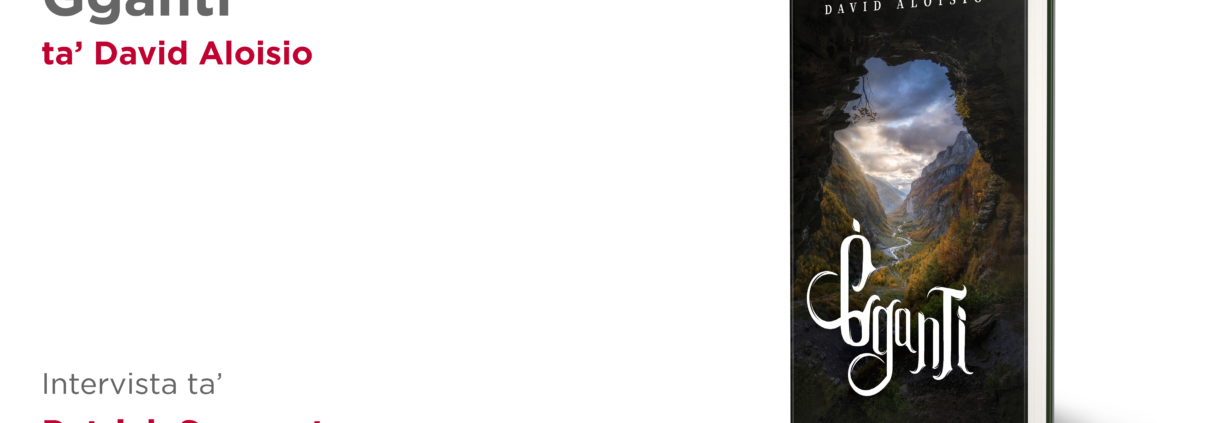Minn Dr Patrick Sammut, Editur IL-PONT
- Ġganti hu rakkont għaż-żgħar jew għall-kbar? Hu rakkont li jista’jitgawda fuq livell letterali, imma żgur jista’ jinftiehem ukoll fuq livell figurattiv. Xi tgħid dwar dan?
Dan ir-rumanz huwa fil-fatt intenzjonat għal udjenza varjata. Ippruvajt nimita t-tradizzjoni li stabbilixxew awturi kbar bħal Lewis Carroll b’Alice in Wonderland, Frank Baum b’The Wizard of Oz, George Orwell b’Animal Farm u Jonathan Swift b’Gulliver’s Travels, li tawna xogħlijiet li għall-ewwel taħseb li nkitbu għaż-żgħar, sakemm imbagħad ma ddumx ma tintebaħ li jħaddnu saffi ta’ tifsir li aktarx jistgħu jiġu apprezzati mill-kbar. Ġieli jiġri, anke jien stess esperjenzat dan, li naqraw mill-ġdid ktieb minn ta’ tfulitna, u bħala “tfal li kbirna” nkunu nistgħu nesperjenzawh b’mod differenti. Allura, iva, dawn huwa rakkont għaż-żgħar li jistgħu jgawduh fuq livell litterali, u huwa wkoll rakkont għall-kbar li jistgħu japprezzaw aħjar id-dimensjoni figurattiva tiegħu.
- Żmien il-paċi u l-armonija bejn ġganti u bnedmin, segwit minn żmien il-ġenn u l-gwerra. Ġganti hi storja li terġa’ tħaddem temi riċiklati għal sekli sħaħ, jew hemm iktar minn hekk?
Bħala bnedmin, aħna nġarrbu, bejn wieħed u ieħor, l-istess emozzjonijiet u xi drabi, għalkemm jeżistu d-differenzi, ikollna esperjenzi tal-ħajja li joqorbu lejn ta’ xulxin. Anke fuq livelli li jmorru lil hinn mill-ħajja individwali u personali tagħna, l-umanità donnha tirriċikla l-ġrajja tagħha stess – kif ngħidu, l-istorja tirrepeti ruħha. U dan kollu huwa s-sors komuni tal-ispirazzjoni letterarja. Il-ħila tal-kittieba hija dik li jippruvaw joħolqu xi ħaġa oriġinali b’din il-materja prima u bl-għodod li għandhom. Fi Ġganti ppruvajt noħloq (jew aħjar, inkompli nikkontribwixxi għall-ħolqien ta’) mitoloġija Maltija billi nagħti interpretazzjoni purament fantastika tal-preżenza tat-tempji megalitiċi, tal-cart ruts u ta’ xi karatteristiċi oħra tal-ambjent ta’ madwarna. Qgħadt attent ukoll li ma nsemmix lil Malta b’isimha, biex ma nintrabatx ma’ pajjiż wieħed u biex nagħti xeħta aktar universali lir-rakkont. Madankollu, is-sors tal-ispirazzjoni tiegħi tal-ambjent deskritt huwa evidenti u ovvju għall-qarrejja lokali.
- Il-popolazzjoni tal-bnedmin dejjem tikber u l-bini dejjem jiżdied tat-torrijiet, il-qirda tas-siġar, ir-regħba għall-poter, u ħafna iktar. Kemm hu ispirat minn avvenimenti kontemporanji u forsi anki lokali rakkont bħal dan?
Iva, fil-qofol tat-tematika tar-rumanz hemm it-tema ambjentali. U proprju l-bidu tal-bini tal-ewwel torrijiet, jew high-rise buildings, f’pajjiżna kien dak li instigani biex nibda nikteb dil-ġrajja simbolika. Għalhekk, minkejja li Żita, il-protagonista, donnha tmur lura fiż-żmien meta ssib ruħha fil-gżira tal-ġganti, fil-fatt qiegħda tesperjenza ġrajjiet u ħsus simili għal tagħna, iċ-ċittadini tal-lum li qed naraw, Herbert Ganado jaħfirli, Malta tinbidel.
- Minn fejn ġejjin jew kif twieldu ismijiet bħal Anak, Gordo, Kfir, Keres, Matera, Suna, Tanu, imma anki Nada, Ġola u Żita? X’effett xtaqt li jilħqu?
Dil-mistoqsija interessanti nista’ nweġibha b’diversi modi. L-aktar raġuni sempliċi hija dik estetika – għażilt ċerti ismijiet, bħal Żita, għax fonetikament idoqquli u naħseb li jistgħu jinżlu tajjeb mal-qarrejja. Imbagħad hemm ismijiet bħal Tanu, minn thanos, bil-Grieg, jew bħal Nada, kelma li teżisti f’diversi lingwi. Ovvjament, l-għażla saret għax aktarx hemm xi konnessjoni mal-karattru li jġorr l-isem. L-isem Anak, mill-banda l-oħra, ifakkar fl-Anakim, id-dixxendenti tal-ġganti li jissemmew fil-Bibbja.
- Fuq naħa hemm il-friefet tal-lejl li jitimgħu lil Ġola u Żita u l-ajkla l-kbira li tgħasses fuqhom; fuq l-oħra hemm waqtiet meta elementi naturali partikolari jduru kontra l-bniedem qerried li ċappas idejh bid-demm. X’kien il-ħsieb wara dan?
Dawn il-ħlejjaq li qed tiddeskrivi tant tajjeb donnhom jiffaċilitaw dik li nsejħulha l-ġustizzja poetika, jew is-sens ta’ retribuzzjoni. Fi kliem sempliċi l-ħlejjaq jgħinu biex, sa ċertu punt, jiġu ppremjati l-ftit bnedmin li jħaddnu r-rispett lejn għajrhom u dak kollu li hemm madwarhom, inkluż il-ġganti, u li jiġu kkastigati dawk li mill-banda l-oħra huma l-qerrieda egoisti u l-wikkiela għall-ġid u għall-poter. La qed insemmu l-Bibbja, qed niftakar fil-ġrajja ta’ Noe, il-personaġġ li kien fost il-ftit li n-natura ppermettiet li jsalvaw, f’kuntrast mal-maġġoranza tal-popolazzjoni li nqerdet bid-dulluvju. Inċidentalment, ta’ min isemmi li fil-bidu tal-ġrajja tal-arka ta’ Noe jissemmew il-ġganti (ara Ġenesi 6:4).
- Sabiħ wisq il-kapitlu ta’ qabel tal-aħħar, ‘Il-Ħarba’, fejn l-azzjoni sseħħ taħt il-baħar qrib il-Gżira tal-Ispirti u d-deskrizzjoni għandha mill-oniriku u mill-ideali, f’kuntrast mal-ħerba u l-kaos li jeżistu fid-dinja reali. X’tifsira jew tifsiriet għandu l-baħar hawn?
Qed nieħu gost li apprezzajt dan il-kapitlu. Għalija dan hu l-qofol tar-rakkont għax hawn tiġi deskritta d-dinja ideali, tip ta’ “wonderland”, l-utopija fejn jgħixu f’armonija l-ħlejjaq kollha irrispettivament mid-daqs, mill-ambjent li oriġinaw minnu (art, sema, baħar) u mill-ispeċi li jappartjenu għaliha. Kif implikajt inti, din il-parti tar-rakkont iġġiegħlek tiddubita jekk hix ħolma – jekk ir-rakkont kollu tal-gżira tal-ġganti huwiex ħolma ta’ Żita. U dan jista’ jinvolvi element ta’ diqa; hawn il-mistqosijiet jitnisslu waħedhom: L-utopija tista’ teżisti biss fil-ħolm? In-natura umana ma tippermettix sitwazzjoni ideali bħal din fid-dinja?
- Ġganti hu rumanz li jirrakkonta traġedja – il-firda bejn il-ħbieb – li tħalli vojt kbir, imma hu wkoll rakkont fantastiku li jgħin lill-qarrej joħlom u jitbiegħed għal waqtiet minn realtajiet kefrin. Hemm ukoll żvilupp pożittiv: Żita li terġa’ tiskopri l-qrubija mal-ġenituri tagħha. Kemm hu minn dan kollu?
Qed nifraħ li inti, bħala qarrej attent, osservajt dan kollu. Iva, dawn l-elementi qegħdin hemm, kollha kemm huma. Apparti t-tema ambjentali li ddiskutejna qabel, hemm ukoll temi li jappellaw direttament għall-adolexxenti bħal, kif għedt int, l-idea li fir-rumanz tiġi esplorata r-relazzjoni tal-protagonista mal-ġenituri u mal-ħabiba tal-qalb tagħha Nada. Fid-dinja parallela li ssib ruħha, Żita donnha ssib l-alter ego ta’ Nada f’Ġola. Jista’ jkun li tagħmel dan inkonxjament għax fil-fond ta’ qalbha Żita taf li lil ħabibtha tilfet lil Nada darba għal dejjem?
- Inħoss li hu rakkont li jgħabbi lill-ġenerazzjoni żagħżugħa b’ċerti responsabbiltajiet. Reazzjonijiet tiegħek?
Mingħajr ma ninstema’ pedantiku jew didattiku, ikolli nammetti li iva, dan ir-rumanz jittanta jwassal dan it-tip ta’ messaġġ. Jekk ma jasalx, għall-inqas mill-perspettiva letterarja, ma jkun ġara xejn. Ir-rumanz jista’ jiġi apprezzat għal dak li hu. Imma jekk b’xi mod dan ir-rakkont iqanqal xi forma ta’ kuxjenza ambjentali speċjalment fost iż-żgħażagħ, tant aħjar! Forsi jagħmlu bħal Żita nnifisha fl-aħħar tar-rumanz tidher fuq vapur Ocean Warrior – isem li jissuġġerixxi li wara l-esperjenzi qawwija li għaddiet minnhom, it-tfajla qatgħetha li tiddedika ħajjitha għall-protezzjoni tal-ambjent marittimu.


